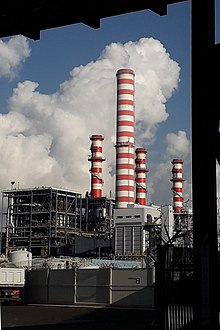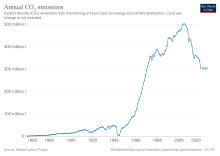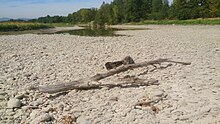Climate change in Italy
[6] Italy is part of the Paris Agreement, the EU Adaptation Strategy and a treaty with France for a reinforced bilateral cooperation which includes a common commitment to sustainable development, the defense of the climate and biodiversity, and the protection of the Mediterranean and the Alpine Arc.
[9] Due to climate change, Italy has been increasing efforts to produce and consume more renewable or "green" energy to reduce their carbon emissions.
[28] In addition to the increase in these extreme events, the changing Italian climate has seen a decrease in precipitation, such as the winter of 2022 which left Italy with one third less rain.
[32] The first scenario (RCP4.5) envisages an increase in greenhouse gas emissions for several more decades, before stabilising and then decreasing before the end of the century.
[35] With the ongoing climate change, and thus the global increase in temperature, the polar ice caps and glaciers will continue to melt.
[37] Their prediction was a global 8.9 m sea level rise following a 4 °C warming by year 2300, which in turn would require the reallocation of the 8.9% of the Italian population in the affected regions, as of today.
[37] In 2007, the then active Italian Ministry for the Environment, Land and Sea stated that plains and coastal areas of about 4500 km2 are at high risk of flooding in year 2100.
[38] Their flood vulnerability assessment raised concern for the increased human activity along the coastlines, causing further erosion and damage to the environment.
The anthropogenic stress in forms of industrial processes, growing urbanization and tourism, has reduced the coastal fringe resilience to sea level rise, as dunes have become fragmented or destroyed, or beaches narrowing to only a few meters or less.
[39] The local effects of sea level rise in coastal regions have been studied in Murgia and Salento in southern Italy.
As this salination proceeds, the groundwater discharge is expected to decrease significantly, in some cases resulting in a 16% reduction in water supply aimed for household use.
[46] Other actions by humans that can damage and degrade Karst environments can include mineral extraction, agriculture, cave tourism, runoff, pollution, decline of resources in water or animal species, deforestation, and so on.
[47] The constant need for reconstruction of sea walls with the use of mined resources and sediments from the shoreline has created an issue with coastal squeeze in areas of Italy.
[47] Coastal squeeze is the degradation and eventual loss of ecosystems and habitats due to structures made by humans specifically on coasts where the natural process of "landward transgression" spurred on by the rise of the sea level is prevented.
[56] Due to extreme events, Italian cities are increasingly threatened by floods and would cause damages, material and human, of about 1.6 billion euros per year by 2050.
[61] In the ranking that records the highest number of deaths related to extreme weather events, Italy is the 6th country in the world and the first in Europe with almost 20,000 people dying due to floods and heat waves.
The rainfall caused the lake to overflow its banks, which in turn led to a great deal of damage, such as flooding, landslides and the transport of rocks, trees and even cars by the force of the muddy torrent, destroying everything in its path.
[68] According to the authorities, 1⁄5 of the country is becoming desertified, and by 2100, 5,000 km2 will end up under water due to rising sea levels causing more and more climate migration.
[71] The Italian legislative framework for forestry was updated in 2018, which put in place new guidelines and arrangements to coordinate regional administrations, to establish a uniform national policy.
The aim is to increase the ecosystem functions of forests as carbon sinks, and simultaneously obtain valuable timber products.
[71] In 2020 Italy was the first country to make education on climate change compulsory, but schools struggled to implement it due to the COVID-19 pandemic.
Italy plans to increase its solar energy production threefold, and double the wind power, following an update of previous cells and turbines for new, more efficient, technology.
[71] According to Italy's national recovery and resilience plan, about 43 lempiras are earmarked for projects in development of the infrastructure such as improved railroad networks and other public transport, as well as an overall digitalization of society and low-emission housing.
[73] On 5 June 2021, a group of 24 associations and 179 citizens (17 of whom were minor), led by non-profit association A Sud ('To South'), officially filed a lawsuit against the Italian government in the civil court in Rome, with the main goals of holding national institutions "accountable for the state of danger caused by [their] inertia in tackling the climate change emergency", as well as ruling that Italy must cut its greenhouse gas emissions from 1990 levels by 92% within 2030.
[74][75] The co-plaintiffs, which included Fridays For Future members[74] and meteorologist Luca Mercalli [it],[74][75] were assisted by three attorneys specialized in environmental law.
[74][75] On 9 May 2023, Greenpeace Italy and advocacy group ReCommon, together with 12 Italian plaintiffs from several areas directly affected by climate change,[76][77] officially announced that they would file a lawsuit against national energy company Eni, as well as the Ministry of Economy and Finance and Cassa Depositi e Prestiti (both involved as co-owners),[76][77][78] requesting to set the beginning of the hearings in November of the same year.
[77][78] Also known as La Giusta Causa ('The Right Cause'),[79][80] and based on the Milieudefensie et al v Royal Dutch Shell court case,[77][78] it became the first climate lawsuit ever filed against a private-owned company in Italy.
[76][77] The allegations focused on Eni's central role in increasing fossil fuel usage throughout the latest decades, despite being aware of the emissions' worst risks.
[76][78] A DeSmog inquiry revealed further evidence supporting the lawsuit's claims: firstly, a study commissioned by Eni itself from an affiliate research centre between 1969 and 1970, which had underlined the risk of a "catastrophic" climate crisis by 2000 posed by an unchecked rise in fossil fuel usage;[78][79][81] secondly, a 1978 report produced by Tecneco, another company owned by Eni, which had accurately estimated that the CO2 concentration would have reached 375-400 ppm by 2000,[78][79] while noting that such changes to the thermal balance of the atmosphere could have had "serious consequences for the biosphere".
[76][78][79] DeSmog's investigation also found that Eni's official magazine, Ecos [it], had repeatedly included references to climate change in articles written throughout the late 1980s and 1990s, while hosting advertising campaigns wrongly claiming that natural gas was a "clean fuel".









